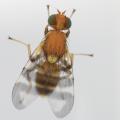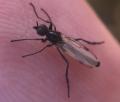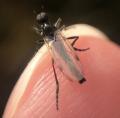Diptera.info :: Identification queries :: Diptera (adults)
Who is here? 1 guest(s)
|
Carcelia sp. or Nemorilla floralis?
|
|
| Di-dier |
Posted on 15-12-2007 19:04
|
|
Member Location: Bruxelles Posts: 43 Joined: 05.03.07 |
Here is a question for "Tachinologists". I have borrowed some species of Tachinidae from my local museum (I live in Brussels). This material is already determined. The idea is to improve my use of Tschorsnig's key to european Tachinidae. I think that there is a mistake for one specimen determined as Nemorilla floralis. The ratio between peristome/maximum eye diameter is 1/12 like for the genera Carcelia. But I have a doubt because no descriptions of species of Carcelia really match this specimen. There is no additional feature in Tschorsnig's key or Belshaw's key for separate these two genera.  Carcelia has a strong inner bristle on the middle tibia. Is it the same for Nemorilla? Do you know another feature for discriminating these two genera? Thank you in advance for your help. Didier |
|
|
|
| Zeegers |
Posted on 16-12-2007 12:06
|
|
Member Location: Soest, NL Posts: 18546 Joined: 21.07.04 |
The gena is very narrow in Nemorilla, so the mistake is easily made. To keep it very practical: in Nemorilla the legs are completely dark, the second antennal segment is elongated and the apical scutellar bristles are small. In all Belgium Carcelia (don't try this with material from far abroad !) the tibiae are at least partially reddish, the second antennal segment is shorter and the apical scutellar bristles are well developed (less so in tibialis). Nemorilla floralis has a very distinctive colouration, reminiscent of Meigenia males. Once you've seen it, you will pick it out even from a distance. Hope this helps Theo |
|
|
|
| Di-dier |
Posted on 16-12-2007 19:37
|
|
Member Location: Bruxelles Posts: 43 Joined: 05.03.07 |
Thank you Th?o. The ideal situation would be to have a diagnosis of all the european tachinid genera, but there is something like 230 genera...  |
|
|
|
| Zeegers |
Posted on 16-12-2007 21:09
|
|
Member Location: Soest, NL Posts: 18546 Joined: 21.07.04 |
Didier, what was the verdict ? Theo |
|
|
|
| Di-dier |
Posted on 17-12-2007 15:27
|
|
Member Location: Bruxelles Posts: 43 Joined: 05.03.07 |
Thanks to your help, it's obviously Nemorilla floralis. Besides, I have a couple of Meigenia sp. As you said, these two genera are close from each other. Is there something rather misleading in Tschorsnig's key or I have a problem when I'm measuring proportions? Cheeks (at the level of antennal base) were obviously wider than the peristome and the ratio max. eye diameter/peristome were 1/12. Two features which lead to Carcelia... |
|
|
|
| Zeegers |
Posted on 17-12-2007 20:37
|
|
Member Location: Soest, NL Posts: 18546 Joined: 21.07.04 |
It depends on the angle you look. Moreover, genera like Nemorilla, Huebneria and Tryphera have narrow gena. In direct comparison, those of Carcelia are much narrower ! But without comparison, the mistake is easily made. Theo |
|
|
|
| ChrisR |
Posted on 18-12-2007 11:02
|
|
Administrator Location: Reading, England Posts: 7699 Joined: 12.07.04 |
Measuring the relative proportions of tachinid parts can be a bit tricky for novices - especially if you haven't got examples of the different genera to look at. But once you understand how to view the head (angle and exactly what you are measuring) the measuring isn't very tricky at all. In fact Matt Smith & I are working on a webpage for our site where we aim to show photographic examples of some of the trickier key couplets. Nothing to report yet but I'll let you know when it's ready  But back to Carcelia ... they really do have an exceptionally thin gena and, although they are not 'all eye' in the way that pipunculids are, they are very hard to confuse with anything else when you can see the head clearly.  Dima took some nice head photos, which you can see here: http://tachinidae...brcno=5305 and I have one - not very good quality but you should be able to see the difference between a Carcelia and your specimen  http://tachinidae...brcno=5307 Edited by ChrisR on 18-12-2007 11:08 |
| Di-dier |
Posted on 19-12-2007 19:57
|
|
Member Location: Bruxelles Posts: 43 Joined: 05.03.07 |
Thank you Chris. My specimen has a wider gena than Carcelia sp. on your pictures. It seems that I have measured from an angle which didn't allow me to see all the gena... Moreover, my own collection doesn't allow me to do some comparaisons needed to split close genera. But my collection will grow this summer for sure!  |
|
|
|
| Jump to Forum: |














 but don't see the image in the post.
but don't see the image in the post.